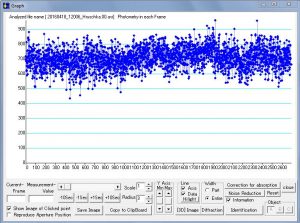
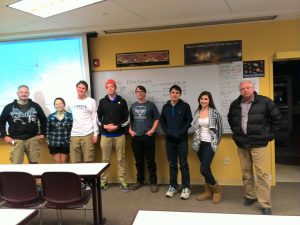
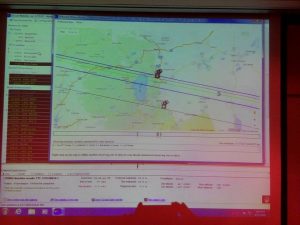

With Red Sumner, Patty Bean, and Carson High Students. Unfortunately we had a miss.





With Red Sumner, Patty Bean, and Carson High Students. Unfortunately we had a miss.
I was practicing for a RECON campaign the other evening. Everything was up and running and my first alignment of the night was a quick success. At that point I sent the telescope off to the first RECON field of the night. After getting there I needed to change the camera setting to a senseup of x128. When I touched the camera housing I felt the tiniest of a static electricity spark leap from my finger to the camera. That’s very unusual but it was a really dry day.
Here’s the thing: at the instant I felt the spark the sound of the telescope drive motors changed pitch and volume by a little bit. Of course, the telescope is tracking and it makes its quiet humming sound as it works. An abrupt change like that got my spidey-senses tingling but there didn’t seem to be any major problems except I saw the telescope was no longer tracking perfectly. I was seeing a very slow but inexorable drift of the field on the camera image. Not good, but I still wasn’t sure there was much of a problem. But, better safe than sorry. I decided to redo the pointing.
Well, redoing the pointing wasn’t helping at all. I tried three times in a row, changing stars each time and by the end I knew that something was very wrong. I’m at least one of those attempts should have worked. Rather than try, try again without changing anything, I decided I would start all over again. That means turning off the power to the telescope and letting it sit a minute. After I turned it back on I was quickly able to get a good alignment and quickly found the RECON campaign field. So what happened?
I think the static spark caused the GPS information (time or position) to be corrupted. My theory is that this information is loaded at the very start and isn’t updated again. After the spark, either a bad position or time meant the computer was doomed to failure since the stars would never appear to be in the right place. That would also make tracking and pointing all wrong. The odd thing is that the telescope, camera, and computer all thought everything was fine.
This experience is worth sharing as an example of one way things can go wrong and how to recover. The key, as always, is to 1) know your equipment and that means practice, and 2) pay attention to your equipment and what it’s telling you when in use. I never would have thought a static spark could do this but that myth has now been dispelled. I wonder how many of you have been inadvertently bitten by this failure mode. I suspect this will only happen when it is very, very dry out and even then will still be rare. In my case, the relative humidity was below 10% and I only got that one little spark the entire night. I sure am glad it wasn’t just before an actual campaign event!
Just wanted to wish everyone in RECON a happy Spring Equinox, which occurs at 9:30PM PDT tonight (20 March @ 4:30 UT)!
We also wanted to take this moment thank the RECON network for a great year. Our Southern RECON teams met in Kingman, Arizona, one year ago today!
While entering RECON site coordinates into my IOTA (Occult4) site database I noticed several little known (to me) facts. I thought I would share these with the rest of the RECON community:
The RECON team network is a very widely spaced community of observation sites, spanning:
Way to go RECON!
Many occultation observations never make it to the analysis stage, as it is clear that the observation is either a negative (miss) or impossible to analyze due to outside effects such as clouds or technical problems. However, when there are difficulties it often pays to perform an analysis anyway, to make sure that something is not present in the video. The (268) Adorea observation by Chris Patrick is a perfect example.
(268) Adorea was advertized to the IOTA and RECON observers in Arizona, Nevada, and California. Three observers were able to observe the event and report results. The path map is shown here:
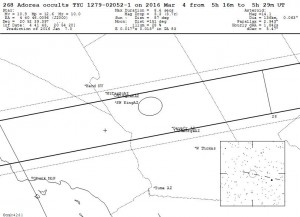
Chris Patrick near Kingman, AZ was the only person to get a positive video observation. Initially, he was not sure if there was anything on the video, due to the thin clouds that obscured the observation. Never-the-less, he submitted the video for analysis.
Tony George was able to review the video using both Limovie and R-OTE. Limovie produced a light curve as shown below:
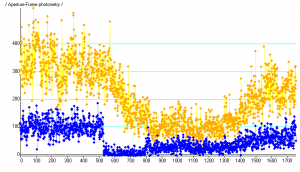
The blue light curve is the target star. The yellow light curve is a very nearby, slightly brighter, secondary star. Thin clouds obscured the occultation, causing both light curves to drop over the course of the observation. The blue light curve looks like ‘maybe’ there is an occultation, but it is hard to tell.
Because the secondary star was not occulted, it can be used as a ‘reference’ star by which the brightness of the target star an be normalized. The only variation of the brightness of the secondary star is due to dimming caused by passing clouds. If this dimming is normalized out of the target star light curve we can see if there was an occultation.
R-OTE was used to normalize the target star light curve. The resulting light curve is shown here:
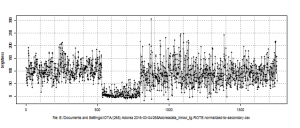
Now, there is a clear occultation event. Analysis showed the event to be nearly 8.9 seconds long, even longer than the maximum duration predicted for the event. This event, coupled with the two other chords — one positive and one miss — resulted in an estimate of the size and shape of Adorea as follows: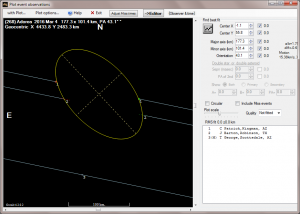
The key to the above result is the hard won observation obtained by Chris Patrick of the RECON team. Congratulations to Chris for this great observation.
There are many more good events occurring with paths crossing RECON teams in the month of March. Good luck to all who try these events.
Our first RECON manuscript has been published in The Astronomical Journal and featured in AAS Nova.
The paper describes the design and development of the RECON Project and will serve as an important technical reference for future results papers.
Thank you again to all of our RECON students, teachers, and community members for your continued contributions to this citizen science research effort!!!
Below are details for an optional RECON Main Belt Asteroid this Thursday evening. Team members in Parker, Havasu, Mohave Valley, Bullhead/Laughlin, Kingman, and Searchlight are well situated for this event. Feel free to sign up on OccultWatcher and/or let us know if you plan to observe. Again, this is an optional event, but great practice and a targeted opportunity for the above teams to get a positive occultation measurement and create object profile!
Date: 2016 March 4 UT
Recording Window: 05:27:00 – 05:28:00 UT
RA: 04:41:43 (of date)
DEC: 20:54:20 (of date)
Sense-Up: x4
Below is a starchart for the event:
This was the last event for February posted by Tony George. The event ocurred early evening on Feb 25 at around 7:38 PM (PST). Predicted event time was 03:38:34 UT February 26th. The target star (11.6 mag.) for the occultation was low in the west at 27 deg altitude and in the constellation Pisces. The predicted maximum duration was 1.6 seconds at the predicted centerline. On the Occult Watcher prediction map my location was just outside (2 km) on the south side of the shadow path in the 1 sigma zone. I had previously contacted Red Sumner at the Jack C. Davis Observatory to see if he could possibly observe. The observatory was only a few kilometers off the predicted centerline. Although partly cloudy most of the afternoon, the clouds started to clear by early evening and there appeared to be a good chance for an observations. Scope setup went quickly, but just before event time a small patch of cirrus moved over the field stars. I set the camera integration to 8X and the VirtualDub timer program to record for 5 minutes centered around the predicted time. Then it was just to hope for the best. Sure enough, the clouds cleared and almost exactly at the predicted time I observed a short ‘wink’ of the target star. A follow-up analysis by LiMovie confirmed an approx. 1.7 second occultaion event. Tony George was gracious enough to provide a formal R-OTE analysis as seen below.

The actual camera and VTI corrected duration was 1.670320 seconds. This event turned out to be one that could have been observed by as many as three RECON sites (Gardnerville, Yerington, and perhaps Hawthorne). It appears though that, as of this writing, I was the only positive observer. A formal report was filed with the IOTA using the OW IOTA Reporting plug-in which uses a simple Excel spreadsheet format.
Reported IOTA occultation results for all of North America can be viewed at : http://www.asteroidoccultation.com/observations/Results/
This Blog is contains advance alerts for main belt asteroid events that may be of interest to select RECON teams where the path crosses their specific observing locations. Teams in the Pacific Northwest will be pleased to see that the majority of the events are favorable to the Oregon and Washington Teams.
Alerts are Not Mandatory
These alerts are not part of the RECON campaign. I have permission to send out these alerts, but they are not mandatory. Should any individual or team in RECON chose to observe these events, it is entirely voluntary. Observing these events will contribute to understanding the main belt asteroids, but it will also provide opportunities for RECON teams to practice their skills and keep interest in observing occultations. Nothing inspires an occultation astronomer more than seeing a star on the video screen wink out as predicted and then suddenly reappear.
Format of Alerts
For events occurring in March, each alert is listed below. For each alert, the path map can be used by observing teams to decide if they should attempt to participate in the event. If your team is not near or within the path, then there is no need to respond to the alert.
For each alert, the following information is listed:
Teams or individuals who plan to participate in the event should sign up for the event on OccultWatcher. Also, you can send me an email directly at triastro@oregontrail.net and I can communicate directly with team members to provide guidance on camera settings, finder charts, recording times and where to post your videos. In special cases, if there is enough interest, I might post a specific blog highlighting a specific event.
Summary of March Main Belt Asteroid Occultation Events
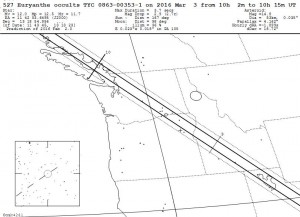
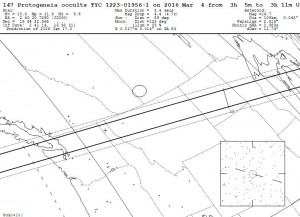

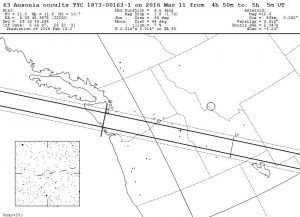
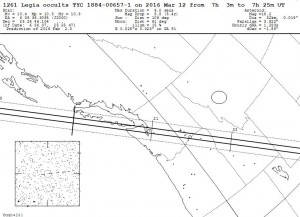
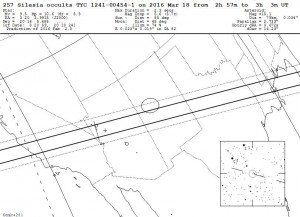
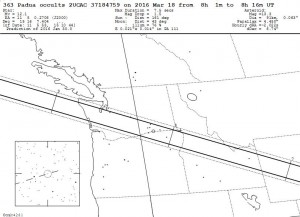
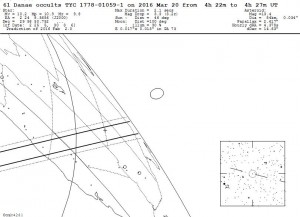
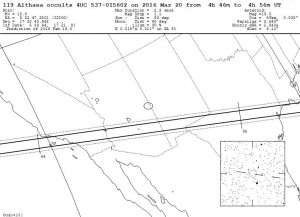
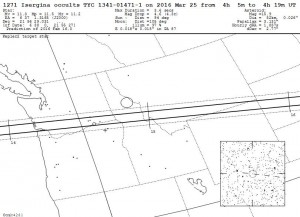
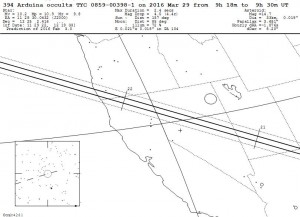
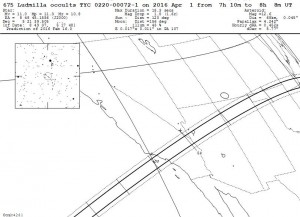
While we do not have any full network TNO campaigns scheduled this month, the map below shows a unique opportunity for all RECON teams in California, Nevada, and Arizona to celebrate Presidents Day by participating in an optional occultation campaign involving Main Belt Asteroid (130) Elektra!
This event occurs February 16 around 08:37:00 UT, so after midnight on Monday evening/Tuesday morning (12:37AM Pacific Time and 01:37AM Arizona Time). The maximum event duration is 15.1 seconds and teams can read the predicted event time off the map above. Because Elektra (mag 11.8) is brighter than the star it is occulting (mag 12.3), the occultation will be very faint as the combined brightness drops by only half a magnitude. Tony George has offered to help with data analysis to generate light curves for participating teams.
Date: 2016 February 16 UT
Recording Window: 08:36:00-08:39:00 UT
RA: 09:35:26 (of date)
DEC: 12:57:38 (of date)
Sense-Up: x4
Below are starcharts and star fields provided by Bill Gimple from Greenville.